Effects of Nonaerated Circulation Water Velocity on Nutrient Release from Aquaculture Pond Sediments
Abstract
:1. Introduction
2. Experimental Apparatus and Method
2.1. Experimental Apparatus
2.2. Experimental Method
3. Results
3.1. Changes in the External Factors Affecting the Overlying Water during Culture Periods
3.1.1. Water Temperature
3.1.2. DO and ORP
3.1.3. pH
3.2. Effects of Flow Rate on NH3-N Concentration
3.3. Effects of Flow Rate on NO3-N Concentration
3.4. Effects of Flow Rate on SRP Concentration
4. Discussion
5. Conclusions
- Flow rate influenced ORP in the overlying water (pH = 6.5 to 7.0) slightly. Although the experiments were implemented under nonaerated conditions, the water could become re-aerated at certain flow rates.
- For the flowing-water conditions, a steep vertical gradient was observed in the NH3-N concentration between the overlying water and the porewater. A higher flow rate was found to correspond to a lower NH3-N concentration in the overlying water, a larger gradient in the NH3-N concentration in the sediments, and a faster release rate of nutrients from the sediments. The trends in NH3-N concentrations were well described by a cubic function.
- The NO3-N concentrations in the overlying water and sediments tended to increase during the first five culture days, but then declined from the 6th day onward. For the still-water condition, because there was no flow turbulence NO3-N continued to be released, with some anaerobic NO3-N likely nitrified to NO2-N. The trends observed in the NO3-N concentration were well described by an e-based exponential function.
- The P release from the sediments was controlled by an adsorption–desorption process. The maximum P release rate from the sediments was achieved at an early stage.
Acknowledgments
Author Contributions
Conflicts of Interest
References
- Henderson-Seller, B.; Markland, D.H.R. Decaying Lakes: The Origins and Control of Cultural Eutrophication; John Wiley and Sons: Oxford, UK, 1987; pp. 5–153. [Google Scholar]
- Hecky, R.E.; Kilham, P. Nutrient limitation of phytoplankton in freshwater and marine environments: A review of recent evidence on the effects of enrichment. Limnol. Oceanogr. 1988, 33, 797–822. [Google Scholar] [CrossRef]
- Philippart, C.J.M.; Cadee, G.C.; Van Raaphorst, W.; Riegman, R. Long-term phytoplankton-nutrient interactions in a shallow coastal sea: Algal community structure, nutrient budgets, and denitrification potential. Limnol. Oceanogr. 2000, 45, 131–144. [Google Scholar] [CrossRef]
- Wang, Y.; He, B.; Duan, W.; Li, W.; Luo, P.; Razafindrabe, B.H.N. Source Apportionment of Annual Water Pollution Loads in River Basins by Remote-Sensed Land Cover Classification. Water 2016, 8, 361. [Google Scholar] [CrossRef]
- Green, B.W.; Boyd, C.E. Chemical budgets for organically fertilized fish ponds in the dry tropics. J. World Aqua. Soc. 1995, 26, 284–296. [Google Scholar] [CrossRef]
- Nairn, R.W.; Mitsch, W.J. Phosphorus removal in created wetland ponds receiving river overflow. Ecol. Eng. 2000, 14, 107–126. [Google Scholar] [CrossRef]
- Cheng, X.; Zeng, Y.; Guo, Z.; Zhu, L. Diffusion of nitrogen and phosphorus across the sediment-water interface and in seawater at aquaculture areas of Daya Bay, China. Int. J. Environ. Res. Public Health 2014, 11, 1557–1572. [Google Scholar] [CrossRef] [PubMed]
- Reddy, K.R.; Fisher, M.M.; Ivanoff, D. Resuspension and diffusive flux of nitrogen and phosphorus in a hypereutrophic lake. J. Environ. Qual. 1996, 25, 363–371. [Google Scholar] [CrossRef]
- Kalnejais, L.H.; Martin, W.R.; Bothner, M.H. The release of dissolved nutrients and metals from coastal sediments due to resuspension. Mar. Chem. 2010, 121, 224–235. [Google Scholar] [CrossRef]
- Sondergaard, M.; Kristensen, P.; Jeppesen, E. Phosphorus release from resuspended sediment in the shallow and wind exposed Lake Arreso. Den. Hydrobiol. 1992, 228, 91–99. [Google Scholar] [CrossRef]
- Usui, T.; Koike, I.; Ogura, N. N2O production, nitrification and denitrification in an estuarine sediment. Estuar. Coast. Shelf Sci. 2001, 52, 769–781. [Google Scholar] [CrossRef]
- Baudo, R.; Giesy, J.P.; Muntau, H. (Eds.) Sediments: Chemistry and Toxicity of In-place Pollutants; Lewis Publishers: Boston, MI, USA, 1990; pp. 131–144.
- Giesler, R.; Lundström, U.S.; Grip, H. Comparison of soil solution chemistry assessment using zero-tension lysimeters or centrifugation. Eur. J. Soil Sci. 1996, 47, 395–405. [Google Scholar] [CrossRef]
- Moore, P.A.; Reddy, K.R.; Fisher, M.M. Phosphorus flux between sediment and overlying water in lake Okeechobee, Florida: Spatial and temporal variations. J. Environ. Qual. 1998, 27, 1428–1439. [Google Scholar] [CrossRef]
- Ugo, P.; Bertolin, A.; Moretto, L.M. Monitoring sulphur species and metal ions in salt-marsh pore-waters by using an in-situ sampler. Int. J. Environ. Anal. Chem. 1998, 73, 129–143. [Google Scholar] [CrossRef]
- Moore, P.A.; Reddy, K.R.; Graetz, D.A. Phosphorus geochemistry in the sediment-water column of a hypereutrophic lake. J. Environ. Qual. 1991, 20, 869–875. [Google Scholar] [CrossRef]
- Moore, P.A.; Reddy, K.R. Role of Eh and pH on phosphorus geochemistry in sediments of Lake Okeechobee, Florida. J. Environ. Qual. 1994, 23, 955–964. [Google Scholar] [CrossRef]
- Seeberg-Elverfeldt, J.; Schlüter, M.; Feseker, T.; Kölling, M. Rhizon sampling of porewaters near the sediment-water interface of aquatic systems. Limnol. Oceanogr. Methods 2005, 3, 361–371. [Google Scholar] [CrossRef]
- Smith, E.J.; Fadly, A.M.; Okazaki, W. An enzyme-linked immunosorbent assay for detecting avian leukosis-sarcoma viruses. Avian Dis. 1979, 23, 698–707. [Google Scholar] [CrossRef] [PubMed]
- Zhu, G.W. Pollution Characteristics of the Sediment of the Hangzhou Section of the Grand Canal, China, and Its Pollution Releasing Mechanism and Ecological Effects. Ph.D. Thesis, Zhejiang University, Hangzhou, China, 2001. [Google Scholar]
- Qian, Y.; Chen, Y.C.; Liu, Z.W.; de Giesen, N.; Zhu, D.J. The Influence of a Eutrophic Lake to the River Downstream: Spatiotemporal Algal Composition Changes and the Driving Factors. Water 2015, 7, 2184–2201. [Google Scholar]
- Jensen, M.H.; Lomstrin, E.; Sorensen, J. Benthic NH4+ and NO3− following sedimentation of a spring phytoplankton bloom in Aarhus Bight Denmark. Mar. Ecol. Prog. Ser. 1990, 61, 87–96. [Google Scholar] [CrossRef]
- Sloth, N.P.; Blackburn, H.; Hansen, L.S.; Risgaard-Petersen, N.; Lomstein, B.A. Nitrogen cycling in sediments with different organic loading. Mar. Ecol. Prog. Ser. 1995, 116, 163–170. [Google Scholar] [CrossRef]
- Kemp, W.M.; Boynton, W.R. External and internal factors regulating metabolic rates of an estuarine benthic community. Oecologia 1982, 51, 19–27. [Google Scholar] [CrossRef]
- Henriksen, K.; Rasmussen, M.B.; Jensen, A. Effect of bioturbation on microbial nitrogen transformations in the sediment and fluxes of ammonium and nitrate to the overlying water. Ecol. Bull. 1983, 35, 193–205. [Google Scholar]
- Hakanson, L.; Jansson, M. Principles of Lake Sedimentology; Springer-Verlag: Berlin and Heidelberg, Germany, 1983. [Google Scholar]
- D’Angelo, E.M.; Reddy, K.R. Diagenesis of organic matter in a wetland receiving hypereutrophic lake water: I. Distribution of dissolved nutrients in the soil and water column. J. Environ. Qual. 1994, 23, 928–936. [Google Scholar] [CrossRef]
- Liu, P.F.; Chen, Z.L.; Liu, J. Effects of environmental factors on NH4+ release in tidal flat sediments along the Yangtze Delta. Res. Environ. Sci. 2002, 15, 28–32. [Google Scholar]
- Huang, T.L.; Sun, Y.J.; Li, X.P.; Liu, L.K.; Yu, J. The simulation test of pollutants release from sediments of urban river. Adv. Chem. Technol. Water Wastewater Treat. CCS Int. Conf. 2008, 3, 733–739. [Google Scholar]
- Ogilvie, B.; Nedwell, D.B.; Harrison, R.M.; Robinson, A.; Sage, A. High nitrate, muddy estuaries as nitrogen sinks: The nitrogen budget of the River Colne estuary (United Kingdom). Mar. Ecol. Prog. Ser. 1997, 150, 217–228. [Google Scholar] [CrossRef]
- Wetzel, R.G. Limnology; W B Saunders Co.: Philadelphia, PA, USA, 1983. [Google Scholar]
- Seiki, T.; Iazwa, H.; Date, E. Benthic nutrient remineralization and oxygen consumption in the coastal area of Hiroshima Bay. Water Res. 1989, 23, 219–228. [Google Scholar] [CrossRef]
- Istvanovics, V. Seasonal variation of phosphorous release from the sediments of shallow lake. Water Res. 1988, 22, 1473–1481. [Google Scholar] [CrossRef]
- Strauss, E.A.; Mitchell, N.L.; Lamberti, G.A. Factors regulating nitrification in aquatic sediments: Effects of organic carbon, nitrogen availability, and pH. Can. J. Fish. Aquat. Sci. 2002, 59, 554–563. [Google Scholar] [CrossRef]
- Chong, K.Y. Dynamics of Dissolved Oxygen and Benthic Release of Nutrients in the Bottom Water Layer in Shallow versus Deep Areas in Hong Kong Waters. Ph.D. Thesis, Hong Kong University of Science and Technology, Hong Kong, China, 2010. [Google Scholar]
- Anthony, J.L.; Lewis, W.M., Jr. Low boundary layer response and temperature dependence of nitrogen and phosphorus releases from toxic sediments of an oligotrophic lake. Aquat. Sci. 2012, 74, 611–617. [Google Scholar] [CrossRef]
- Viktorsson, L.; Almroth-Rosell, E.; Tengberg, A. Benthic phosphorus dynamics in the Gulf of Finland, Baltic Sea. Aquat. Geochem. 2012, 18, 543–564. [Google Scholar] [CrossRef]
- Luo, P.; He, B.; Takara, K.; Razafindrabe, B.H.N.; Nover, D.; Yamashiki, Y. Spatiotemporal trend analysis of recent river water quality conditions in Japan. J. Environ. Monit. 2011, 13, 2819–2829. [Google Scholar] [CrossRef] [PubMed]
- Duan, W.L.; He, B.; Takara, K.; Luo, P.P.; Nover, D.; Hu, M.C. Modeling suspended sediment sources and transport in the Ishikari River basin, Japan, using SPARROW. Hydrol. Earth Syst. Sci. 2015, 19, 1293–1306. [Google Scholar] [CrossRef]
- Larned, S.T.; Atkinson, M.J. Effects of water velocity on NH4 and PO4 uptake and nutrient-limited growth in the macroalga Dictyosphaeria cavernosa. Mar. Ecol. Prog. Ser. 1997, 157, 295–302. [Google Scholar] [CrossRef]
- Zhu, G.; Qin, B.; Gao, G.; Zhang, L.; Luo, L.; Zhang, Y. Effects of hydrodynamics on phosphorus concentrations in water of Lake Taihu, a large, shallow, eutrophic lake of China. Hydrobiologia 2007, 581, 53–61. [Google Scholar] [CrossRef]
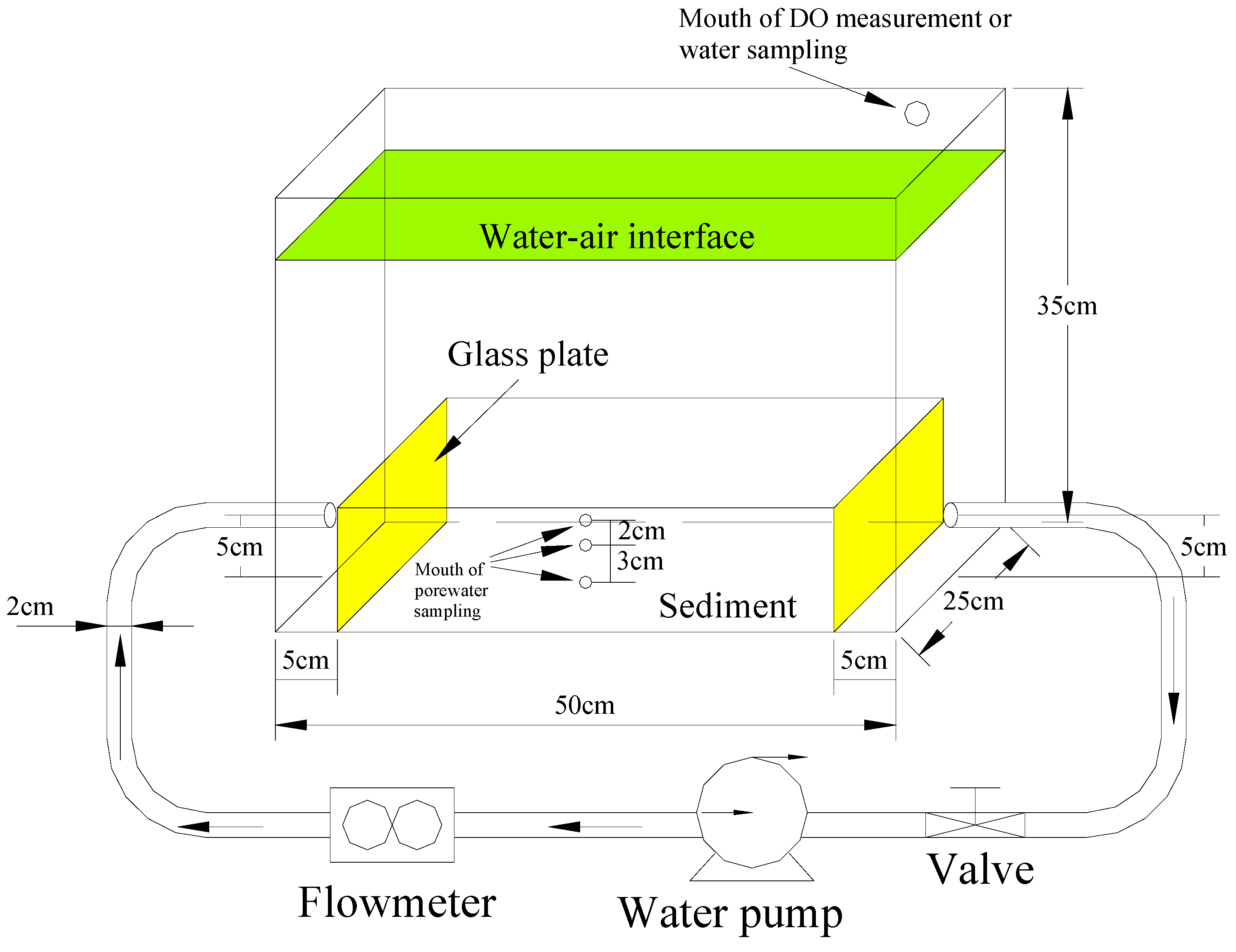
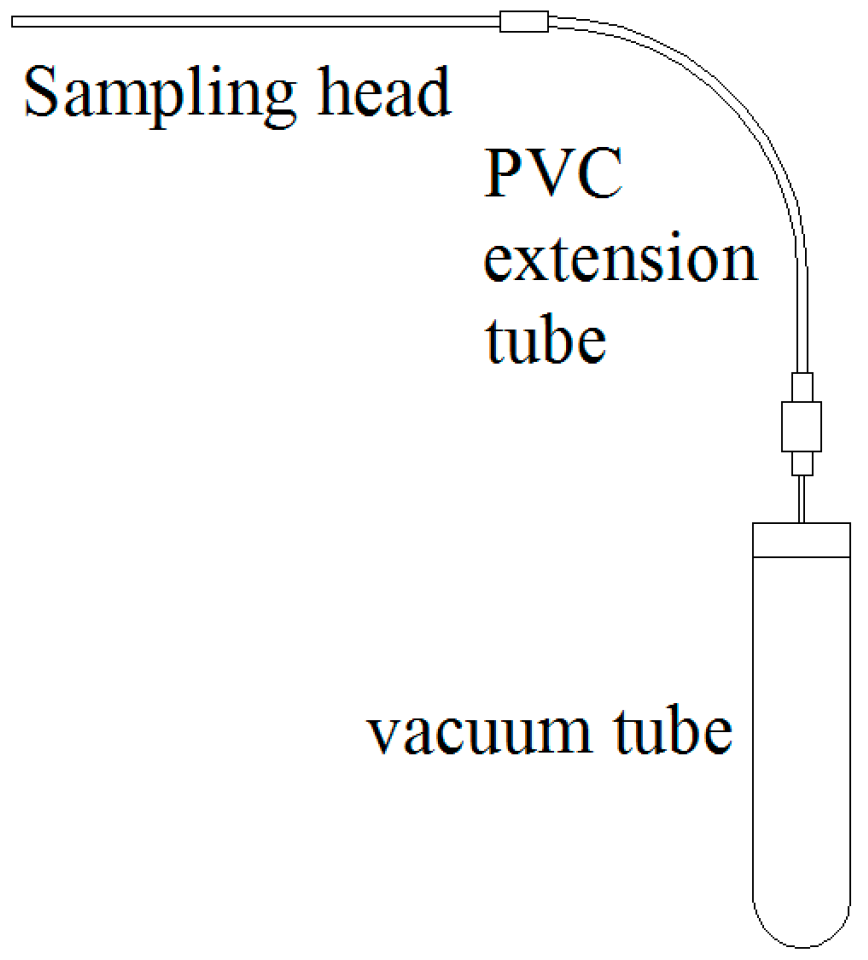


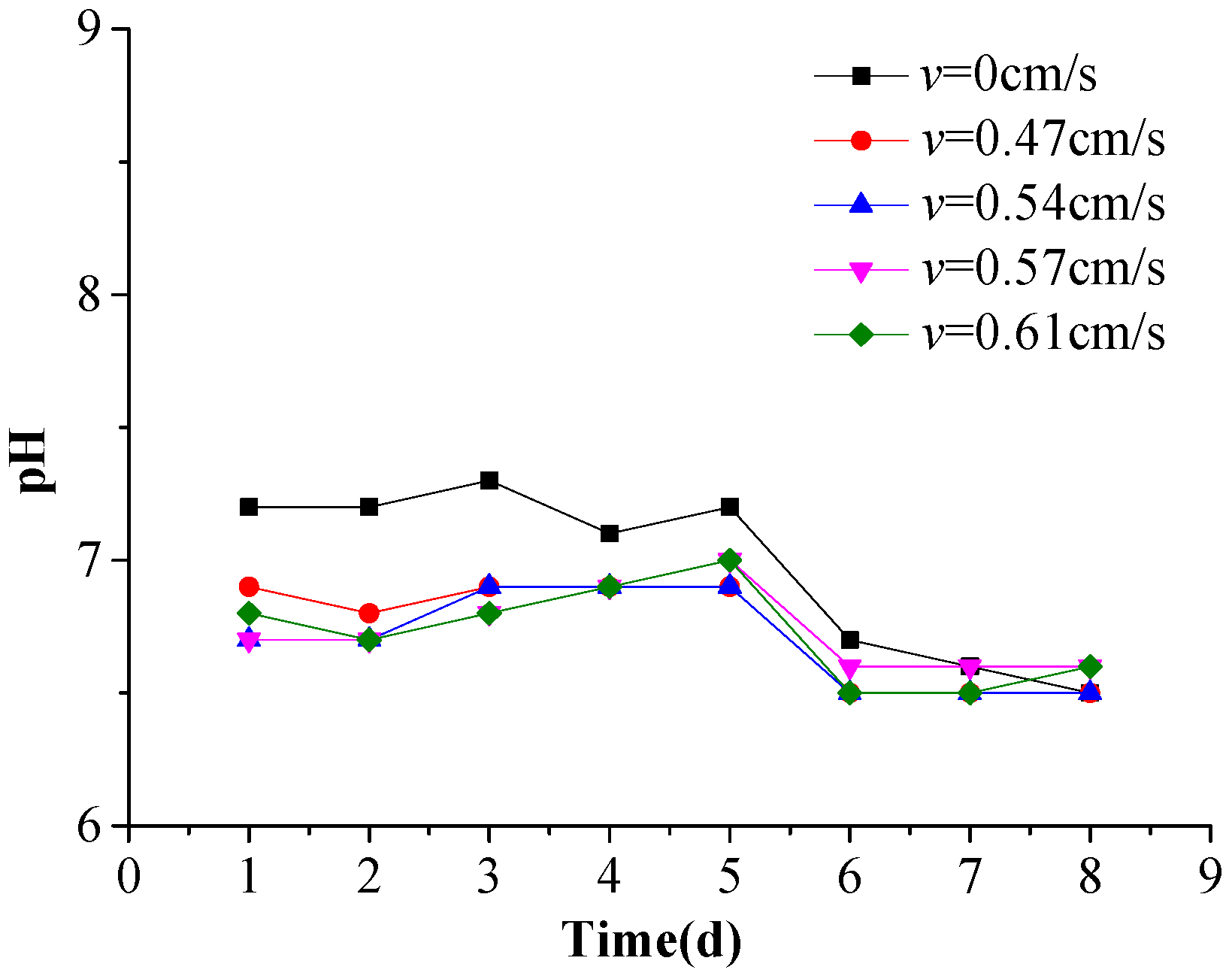
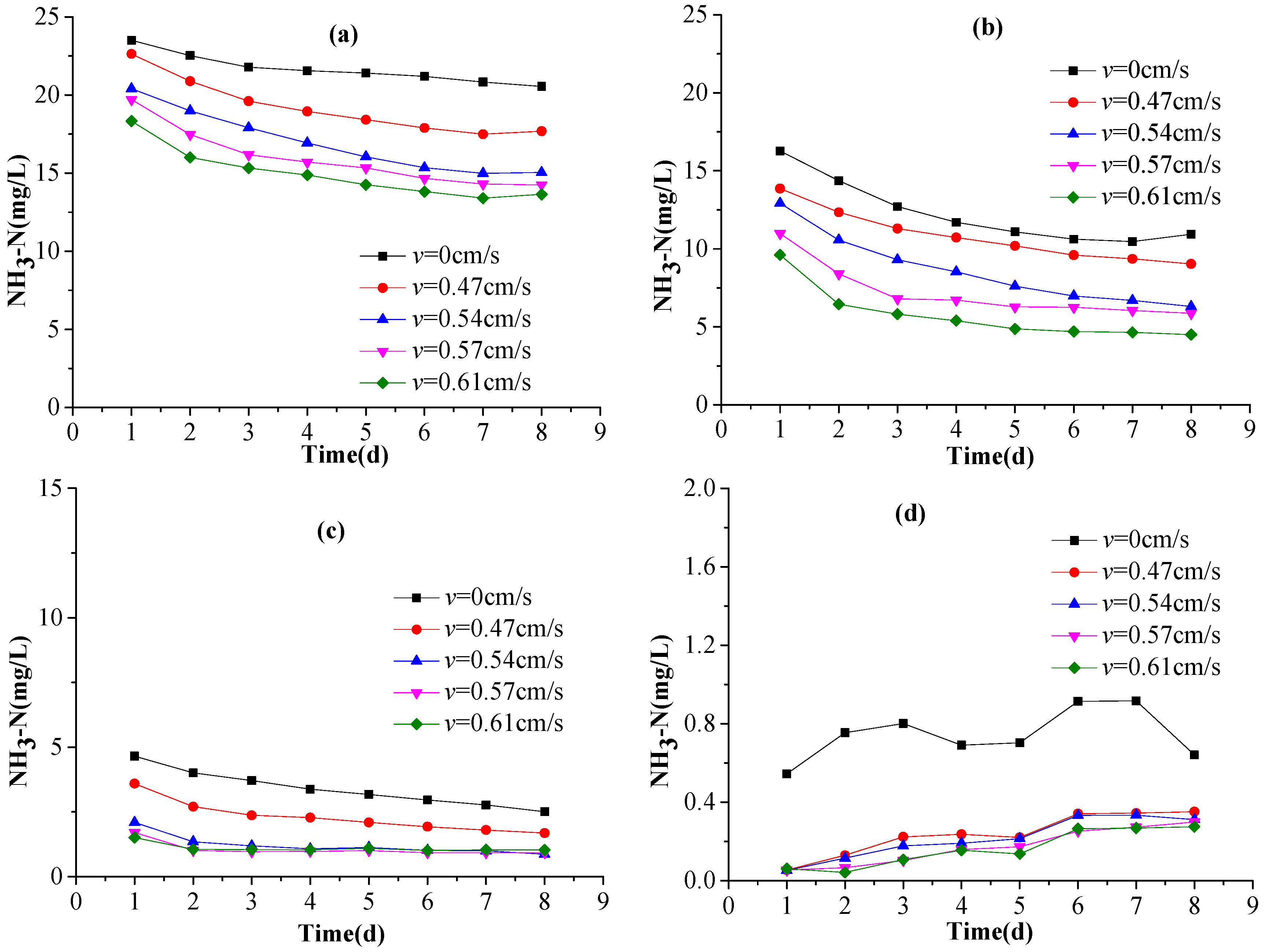
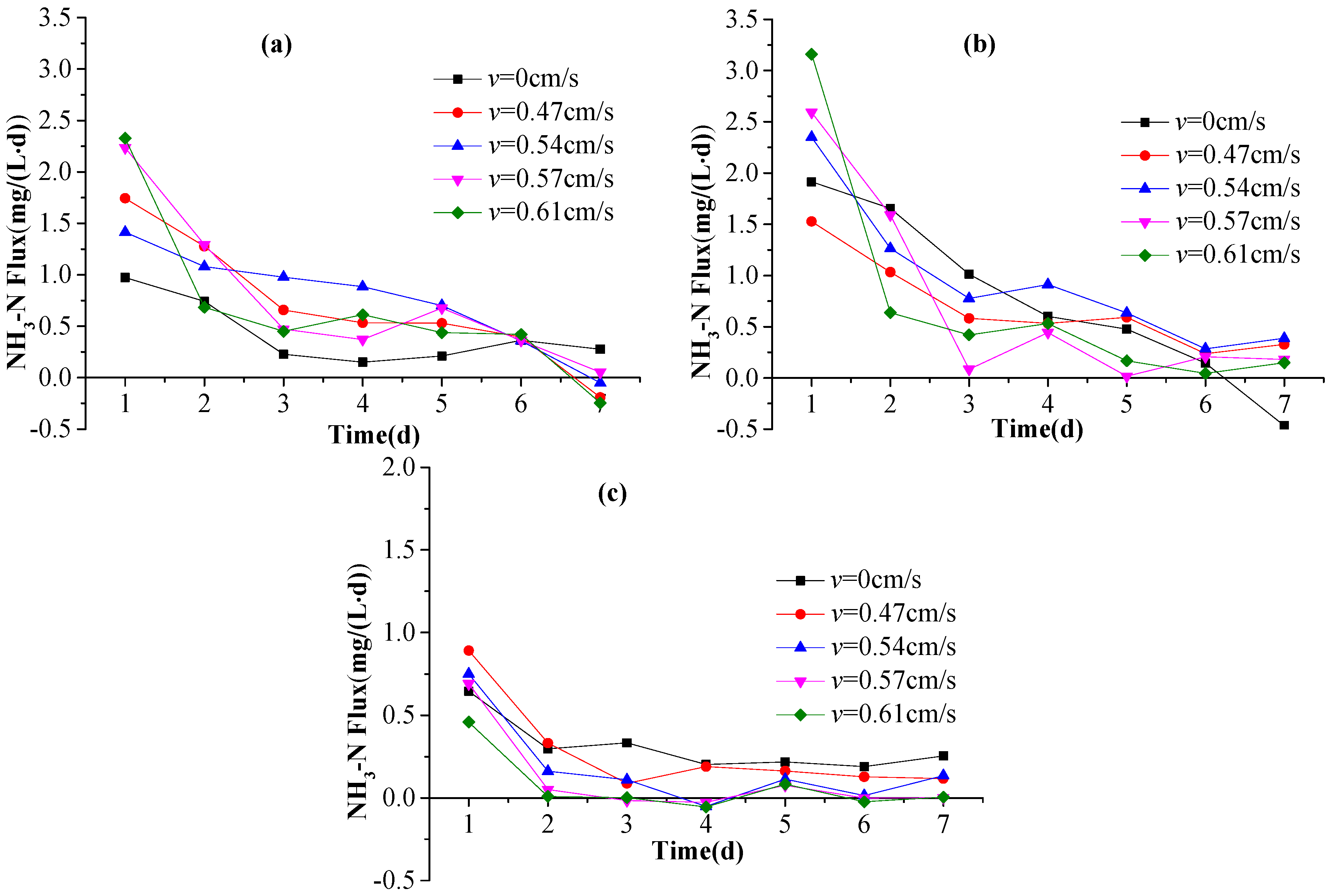
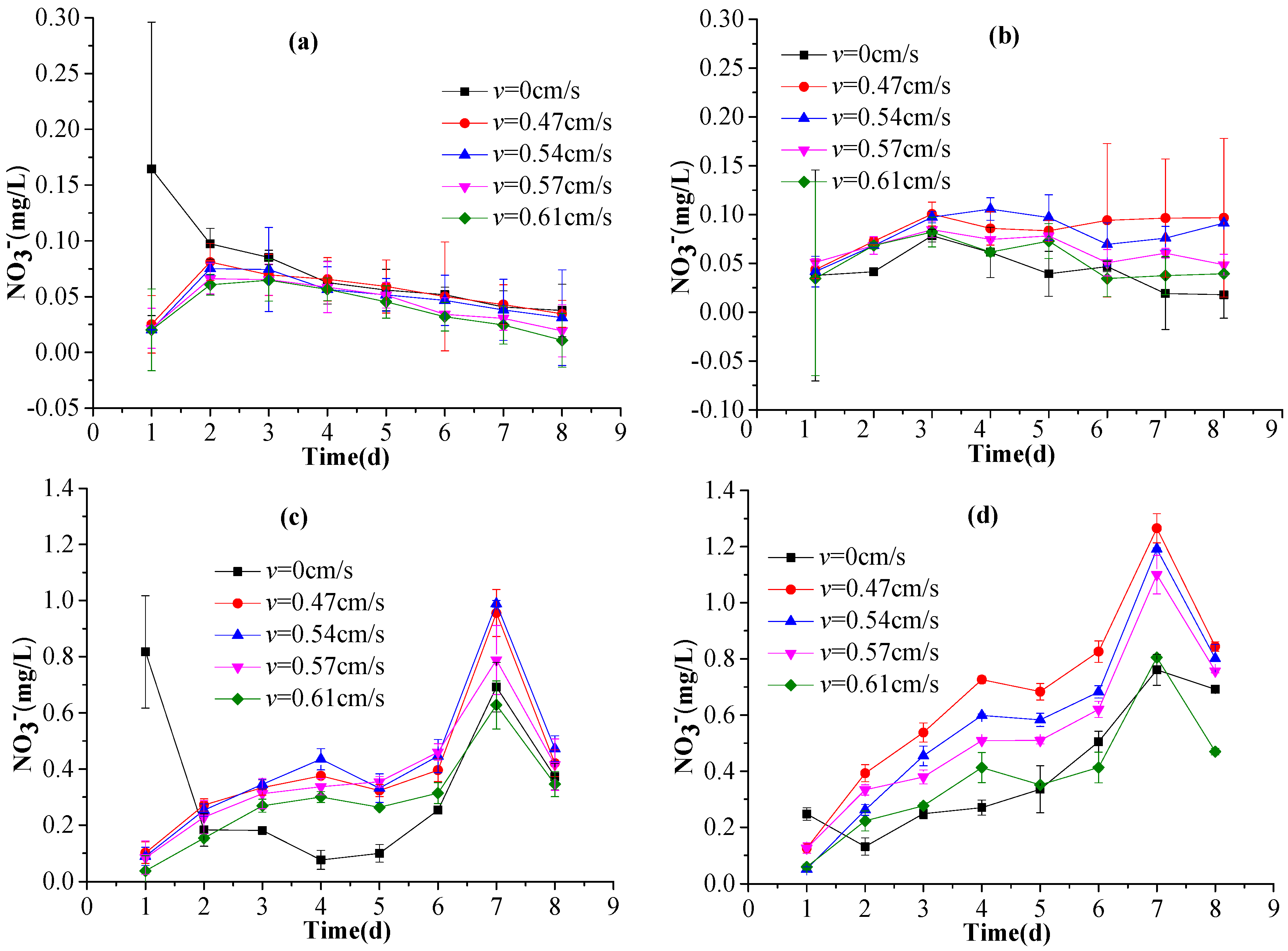
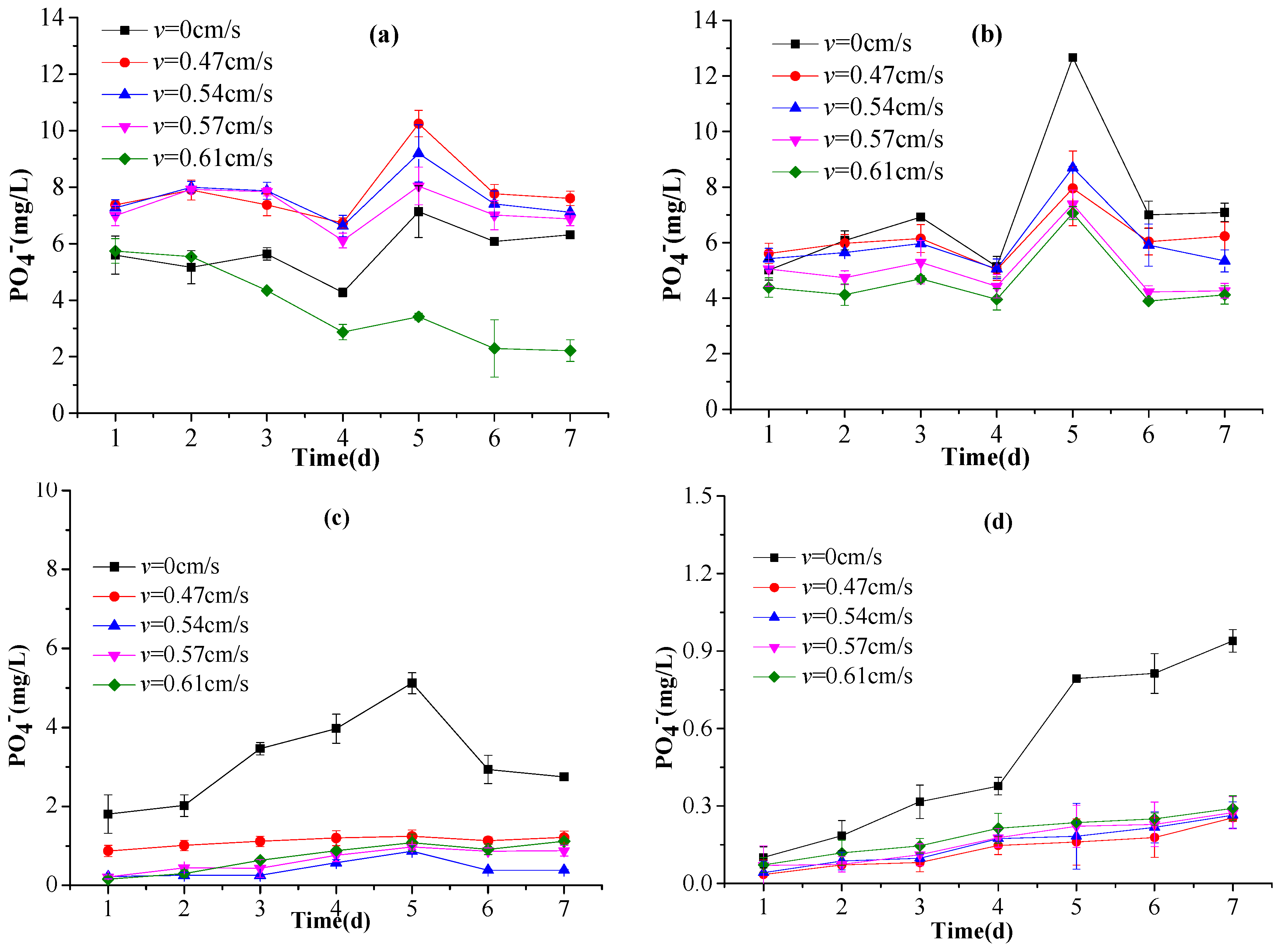
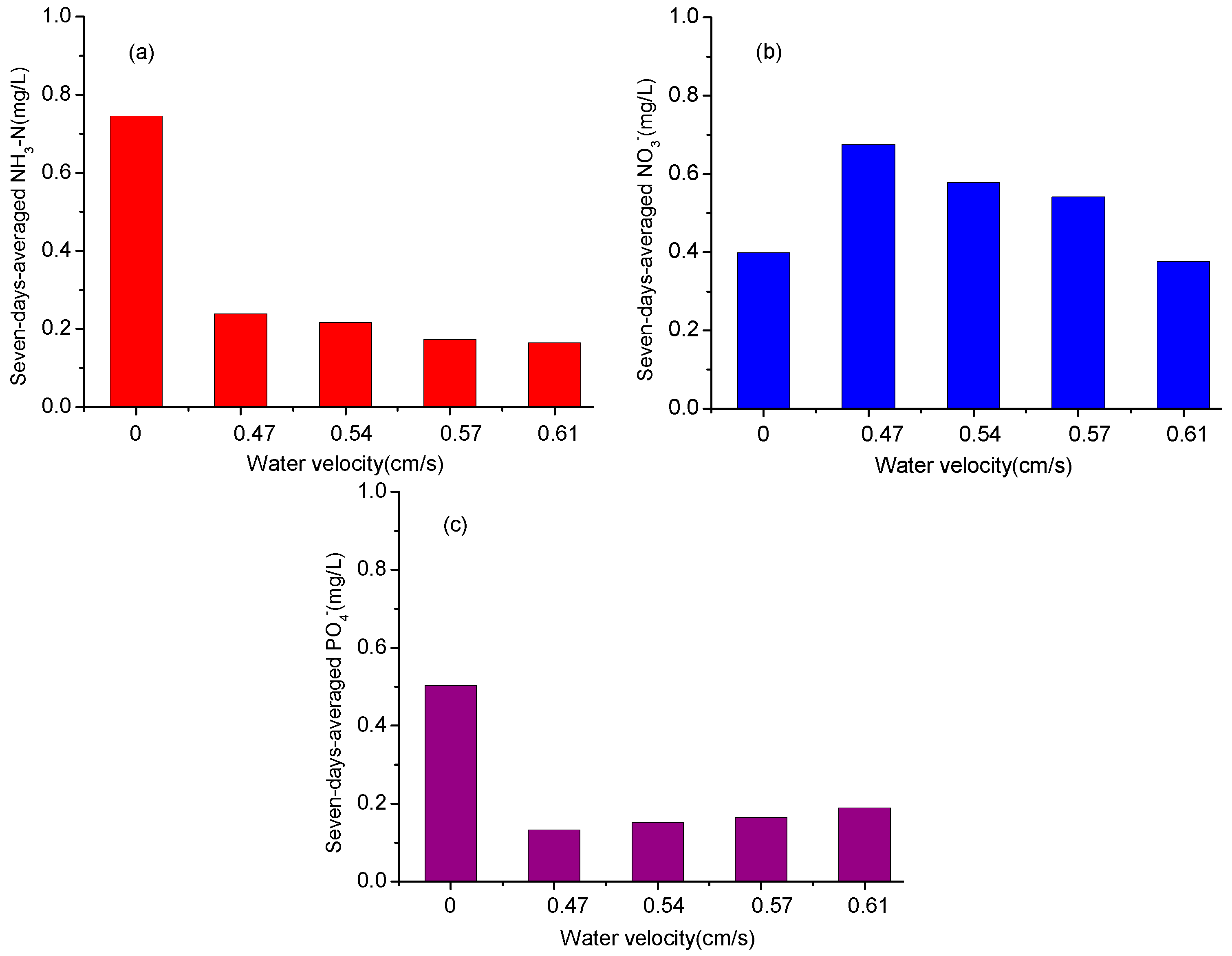
| Sediment Depth (cm) | Velocity v (cm·s−1) | Regression Equation (x: Day; y: Release Flux) | Coefficient of Determination R2 |
|---|---|---|---|
| 6 | v = 0 cm/s | y = 1.75 − 0.858x + 0.152x2 − 0.008x3 | 0.906 |
| v = 0.47 cm/s | y = 3.026 − 1.526x + 0.333x2 − 0.026x3 | 0.975 | |
| v = 0.54 cm/s | y = 1.853 − 0.58x + 0.134x2 − 0.013x3 | 0.995 | |
| v = 0.57 cm/s | y = 4.337 − 2.57x + 0.562x2 − 0.04x3 | 0.971 | |
| v = 0.61 cm/s | y = 4.903 − 3.415x + 0.829x2 − 0.064x3 | 0.972 | |
| 3 | v = 0 cm/s | y = 2.676 − 0.797x + 0.116x2 − 0.009x3 | 0.982 |
| v = 0.47 cm/s | y = 2.362 − 1.002x + 0.181x2 − 0.012x3 | 0.952 | |
| v = 0.54 cm/s | y = 3.753 − 1.793x + 0.349x2 − 0.023x3 | 0.949 | |
| v = 0.57 cm/s | y = 4.808 − 2.57x + 0.459x2 − 0.027x3 | 0.937 | |
| v = 0.61 cm/s | y = 6.2 − 4.046x + 0.873x2 − 0.06x3 | 0.921 | |
| 1 | v = 0 cm/s | y = 0.979 − 0.439x + 0.08x2 − 0.005x3 | 0.895 |
| v = 0.47 cm/s | y = 1.802 − 1.167x + 0.257x2 − 0.018x3 | 0.970 | |
| v = 0.54 cm/s | y = 1.519 − 0.991x + 0.204x2 − 0.013x3 | 0.926 | |
| v = 0.57 cm/s | y = 1.622 − 1.229x + 0.284x2 − 0.02x3 | 0.948 | |
| v = 0.61 cm/s | y = 1.089 − 0.838x + 0.195x2 − 0.014x3 | 0.897 |
| Sediment Depth (cm) | Velocity v (cm·s−1) | Regression Equation (x: Day; y: NO3-N Concentration) | Coefficient of Determination R2 |
|---|---|---|---|
| 1 | 0.47 | y = exp(0.237 − 2.338/x) | 0.955 |
| 0.54 | y = exp(0.286 − 3.263/x) | 0.973 | |
| 0.57 | y = exp(−0.06 − 2.086/x) | 0.894 | |
| 0.61 | y = exp(−0.32 − 2.523/x) | 0.922 | |
| Overlying Water | 0.47 | y = exp(−0.454 − 1.842/x) | 0.769 |
| 0.54 | y = exp(−0.325 − 2.124/x) | 0.832 | |
| 0.57 | y = exp(−0.438 − 2.075/x) | 0.886 | |
| 0.61 | y = exp(−0.532 − 2.742/x) | 0.927 |
© 2016 by the authors; licensee MDPI, Basel, Switzerland. This article is an open access article distributed under the terms and conditions of the Creative Commons Attribution (CC-BY) license (http://creativecommons.org/licenses/by/4.0/).
Share and Cite
Cheng, X.; Zhu, D.; Wang, X.; Yu, D.; Xie, J. Effects of Nonaerated Circulation Water Velocity on Nutrient Release from Aquaculture Pond Sediments. Water 2017, 9, 6. https://doi.org/10.3390/w9010006
Cheng X, Zhu D, Wang X, Yu D, Xie J. Effects of Nonaerated Circulation Water Velocity on Nutrient Release from Aquaculture Pond Sediments. Water. 2017; 9(1):6. https://doi.org/10.3390/w9010006
Chicago/Turabian StyleCheng, Xiangju, Dantong Zhu, Xixi Wang, Deguang Yu, and Jun Xie. 2017. "Effects of Nonaerated Circulation Water Velocity on Nutrient Release from Aquaculture Pond Sediments" Water 9, no. 1: 6. https://doi.org/10.3390/w9010006
APA StyleCheng, X., Zhu, D., Wang, X., Yu, D., & Xie, J. (2017). Effects of Nonaerated Circulation Water Velocity on Nutrient Release from Aquaculture Pond Sediments. Water, 9(1), 6. https://doi.org/10.3390/w9010006







